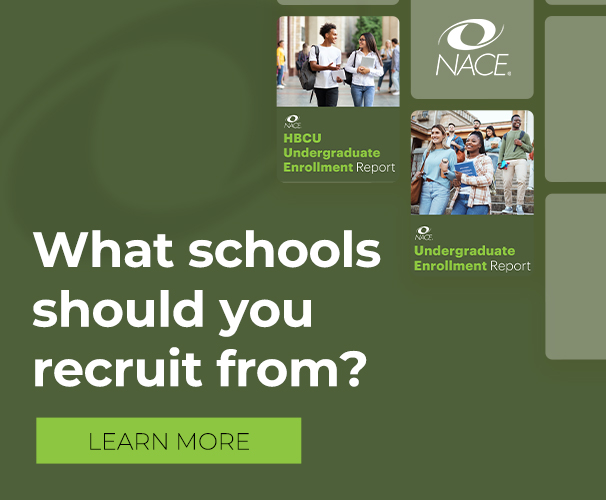Spotlight for Career Services Professionals
When asked why it is important for career centers to target the needs of underrepresented students when digitizing career programs and resources, Arame Mbodj points to trends reported by the Chronicle of Higher Education that show that underrepresented communities will continue to grow over the next few years.
The data indicate that, by 2025, it is expected that there will be:
- Nearly 13.5 million women in college versus 9.9 million men;
- An increase of 32% in Hispanic individuals enrolling in college;
- An increase of 22% in Black students;
- An increase of 16% in Asian and Pacific Islander students; and
- Just a 3% increase in white students.
“Amongst all these marginalized student populations, the first-generation population is at the forefront,” continues Mbodj, assistant director of Career Catalysts, BEAM, Stanford Career Education.
“We also expect there to be an increase in enrollment of first-generation students, and even more with intersecting identities. We recognize the need to create space for these marginalized students in our work and help them understand that we see them and we are here for them. Our student populations will only continue to get more diverse as we know it; we need to be able to change and adapt to their needs and be inclusive as we develop resources, opportunities, and programming.”
Mbodj says it is the responsibility of career services to stay ahead of the curve in order to properly serve this growing community.
“Furthermore,” she adds, “while navigating the higher-education experience comes with its own idiosyncrasies, finding meaningful work and the transition into the workplace compounds the already mounting dynamics this population faces. We recognize that our role is multifaceted as advocates, connectors, and facilitators of learning during this important juncture of their lives. The digital space can be an equalizer in many ways for marginalized students and can create opportunities for more access.”
One of the significant challenges in some of the communities Mbodj works with is a lack of social capital.
“We know that networking is a great way to learn about industries, opportunities, and to even land roles, but when students don’t have a strong network or are unaware that this is a part of becoming a professional, they are even further at a disadvantage from their peers, who may be well connected or have access to a network,” she explains.
“When we think about first-generation and/or low-income, or even international students, this lack of social capital can hinder their career development progression. But if we can provide effective opportunities for early engagement for these students, then we can minimize the impact and break down barriers to building these professional networks and relationships.”
When thinking about it in a more practical manner, it is important to keep in mind students with disabilities or who use assistive technology in higher education institutions.
“As we reflect on the way we’ve traditionally provided information and content, we can now see all the pitfalls and barriers to access many career centers have contributed to,” Mbodj points out.
“We’re now seeing a lot of change in that as technology and digitizing career programs and resources have made it more accessible for us to be more inclusive. As we continue to evolve and grow, we must remain engaged with the needs of marginalized populations to provide dynamic ways for students to connect with similar content, but in more refreshing and connected ways.”
Digitizing career programs and resources can help to address and mitigate these issues. She notes that at the root of every equity and inclusion issue within an organization is a story or perspective that has not been heard, respected, or adequately addressed.
“We recognize the systemic barriers that our marginalized students face, which resulted in us developing career programming through the lens of their identity,” Mbodj says.
“Too often, programs geared toward diversity lump everyone from non-dominant cultures into one category. This creates blanket programs that do not take into account the complexities and layers of different identities.”
To offset this, Mbodj and her colleagues started directly with their students, through surveys and focus groups, and then integrated themselves in spaces for the students.
“Our approach in this work is one where we first come from understandability and we ensure their preparedness, regardless of where they begin,” she explains.
“We hone in on exposing students to different paths available to them to help broaden their perspectives. We then create inclusive spaces just for them by exploring the intersection of career and identity, and building connections with those who can support them on their paths to finding meaningful work.”
Alumni play a pivotal role not only in providing exposure, but in building connections as well.
“Throughout our process,” Mbodj says, “we’re also not afraid to get into the weeds of identity and have those challenging, but authentic conversations about what identity means to them and how we as advocates and guides in the career space can support them.”
Providing robust, tailored career education helps position the career center to better engage and support marginalized students. Doing so via different formats and delivery channels addresses issues with the accessibility of the programs and resources.
“Providing a multitude of ways to deliver content both live and on-demand in innovative ways helps us to draw in more diverse students who might connect with the resources, programming, and career education in ways that may feel more tailored toward their interests, learning styles, and needs,” Mbodj explains.
“This allows students to go at their own pace and refer to resources that pertain to them specifically when they need it.”
Part 2 of this story, which will be included in the October 27 issue of Spotlight, will detail how Arame Mbodj and the team at Stanford University digitize their programs and resources to reach marginalized students.






